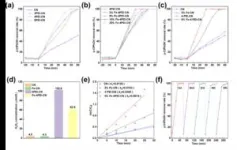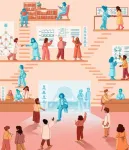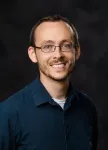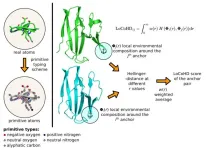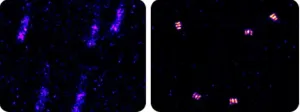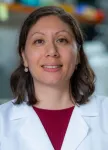(Press-News.org) Shortly after artificial intelligence models including Midjourney and OpenAI’s Dall-E went public, AI-generated art started winning competitions: one in digital art, another in photography. Concern rumbled that AI could replace artists — and even, by some metrics, be more creative than humans. But simultaneously, people were exploring these tools as ways to augment their creative processes, not replace them.
University of Washington researchers grew curious about how AI might affect creativity in children, specifically, so they worked with a group of 12 Seattle-area kids ages seven to 13 to explore how the kids’ creative processes interacted with AI tools. They found that for the kids to be able to integrate generative AI into their creative practices meaningfully, they often needed support from adults and peers.
The researchers presented their findings May 14 at the ACM CHI Conference on Human Factors in Computing Systems.
UW News spoke with the study’s lead author Michele Newman, a UW doctoral student in the Information School, about the study, the importance of support and the particular creativity of kids.
What was the impetus for this research?
Michele Newman: Before coming to UW, I was working on a project using natural language processing — AI, essentially — to measure creativity in elementary school children. When ChatGPT came out, I was at the UW working with KidsTeam, a program where adults and kids co-create technology products for children, and I really wanted to see what effects GPT might have on children's creativity.
So much of the early experience around this new technology was fearful. People were saying, “Don't use it to teach, it's going to harm kids.” Many schools banned it. So part of the impetus of the project was trying to see what a medium stance looks like — where it's not harming or taking jobs. It's supporting and building meaningful experiences for kids. How can we look to the future and build ethical and meaningful practices around this technology?
How did you go about designing the study? And why did you use those design considerations?
MN: In KidsTeam the primary methodology is co-design, where kids are treated as equal partners when designing technologies. So one of our approaches was just putting the kids in front of technology — OpenAI’s ChatGPT and Dall-E, or Google's music generator Magenta — to see what they do. What are their considerations? Where are they getting frustrated? What does it mean to have a tool that can actually kind of do the creation for you? A lot of creativity research talks about how process is very important. That's kind of where the person’s individuality comes out. So we wanted to see the kids develop their creative processes.
We also gave the kids a more structured experience. It's one thing to just look at a piece of technology and say, “Here's what it can do.” It’s another thing to say, “Use this specific software to write a story.” In the sessions, we balanced the open-ended approach with more directed exploration and had kids use techniques like comic boarding, where they make comics about potential good and bad uses of AI.
What findings were the most interesting to you?
MN: Maybe the most important and practical finding is how clearly these systems are not built for children. The kids might know a lot about, say, a video game like Genshin Impact. If the AI system doesn’t know anything about it, the kids might conclude they’re smarter than the system. So there’s a mismatch between what children are expecting these systems to be able to do and what they can do. This type of technology is generally built with adults in mind. Likewise, children's language just isn't the same as adults. Things like this really become an issue for kids trying to creatively express themselves.
The title of this paper is “I want it to talk like Darth Vader,” which is a quote from one of the kids. He was writing a story about Star Wars, and he turned to us and said, “I want it to talk like Darth Vader. I want it to be able to be customized.” He suggested that it would help him write a better Star Wars story. Obviously, you could prompt ChatGPT to talk like Darth Vader, and we helped walk him through that. But those aren't things that the kids necessarily understand right away. They need extra instruction around that. Children's creativity is unique. Because of their development and their experiences, they have different needs than adults do. They're still building and understanding social norms, and what it means to create.
I was also fascinated by the kids’ ethical considerations.
MN: Yeah, when we asked about some typical things like cheating, the kids tended to reiterate things they’ve heard, that “I shouldn't use it to cheat.” But when we asked them about things like whether their friend should use AI to write a birthday card for them, they started to have really nuanced takes. Some started asking how much the friend is using it. Is it to write the whole card, or just to help? Every kid starts to have different ideas. So then we’re considering how to foster an individual child's expression.
We asked one 11-year-old how he’d feel if his favorite book series was written by AI instead of an author, and he said it would “dismantle” the joy of reading for him. We often don't think about kids having these deep, existential questions about what it means to be an artist. But they are. They’re asking whether they lose some authenticity when AI rather than a friend writes a birthday card. Over the course of the study, we saw them changing and developing as they used these systems. By the end, it was great to hear them saying things like, “I don't think this really expresses what I'm saying.”
But they started making certain types of adjustments to their creative process and their goals, which for me sometimes raised a red flag. Sometimes they’d add extra context to get it to do what they wanted. But other times they might try an idea and quickly say, “It's not working, so I'm just going to change the idea.” That’s a hard problem. But we can't just make systems that solve all these issues, because every kid’s process is different. Sometimes you do need to learn to give up on an idea. That can be part of the creative process. So the question with AI is how do you support kids and give them knowledge of their individual creative processes? Creativity is always happening in a larger context. The interaction is not just about inputting a prompt. It’s working iteratively with the system while being supported by peers and adults. And those networks of support make a meaningful experience with these systems much more likely.
Additional co-authors on this paper were Jin Ha Lee, a professor in the iSchool; Jason Yip, an associate professor in the iSchool; Grace Shin, an undergraduate in the iSchool; Ilena B Dalla Gasperina, Matthew Kyle Pedraja and Maia Song, undergraduates in human centered design and engineering at the UW; Ritesh Kanchi, an undergraduate in the Paul G. Allen School of Computer Science & Engineering; Rannie Li, who completed this research as an undergraduate in interaction design and psychology at the UW; and Kaiwen Sun, a doctoral student at the University of Michigan. This research was funded in part by the U.S. Institute for Museum and Library Services.
For more information, contact mmn13@uw.edu.
END
Q&A: How AI affects kids’ creativity
2024-05-30
ELSE PRESS RELEASES FROM THIS DATE:
Virtual lab meetings improve undergraduate research experience and foster diversity in academia
2024-05-30
Moisés A. Bernal, assistant professor in the Department of Biological Sciences at Auburn University, is collaborating with researchers Kathleen Lotterhos (Northeast University), Megan Phifer-Rixey (Drexel University), and Torrance Hanley, (Sacred Heart University) to evaluate the effectiveness of virtual lab meetings in demystifying the hidden curriculum in academia, incentivize primary research among students without previous experience, and foster participation of underrepresented groups in STEM.
The “Biological Practices” article entitled A virtual lab meeting training program mutually benefits mentees and host labs was recently published ...
Study shows effectiveness of updated COVID-19 vaccines wanes moderately over time, is lower against currently circulating variants
2024-05-30
May 29, 2024
Boosters that target the omicron subvariants of SARS-CoV-2 are still providing reasonably durable protection against infection, hospitalization and death from COVID-19, according to new data from a study led by researchers at the UNC Gillings School of Global Public Health.
Published today in the New England Journal of Medicine, the study found that COVID-19 boosters targeting the XBB.1.5 subvariants were most effective one month after receiving one. After four weeks, the vaccines were 52.2% effective at preventing infection and 66.8% effective at preventing hospitalization.
The vaccines were also highly effective ...
Researchers expose new ‘origin’ theories, identify experimental systems for plant life
2024-05-29
STARKVILLE, Miss.—A Mississippi State faculty member’s work on plant life symbiosis—a mutually beneficial relationship between living organisms—is pushing back against the newer theory of “single-origin”—that all life stems from one point—instead suggesting “multiple-origin” theory which opens a better understanding for genetically engineering crops.
Ryan A. Folk, an assistant professor in the MSU Department of Biological Sciences and herbarium curator, is an author on a paper published this month in ...
Researchers honored for outstanding contributions to cancer care
2024-05-29
Three Huntsman Cancer Institute researchers have recently been recognized for their work as outstanding faculty members at the University of Utah (the U).
Kim Kaphingst, ScD, director of cancer communication research at Huntsman Cancer Institute and professor of communication at the U, and June Round, PhD, investigator at Huntsman Cancer Institute and professor of microbiology and immunology at the U, were both granted the 2024 Distinguished Research Award. The faculty prize is given annually to scholars who exemplify exceptional research.
Kaphingst’s group explores cancer communication, particularly how to educate patients and families who ...
A new Hungarian method may aid protein research
2024-05-29
In a paper recently published in Nature Communications, the HUN-REN-ELTE Protein Modeling Research Group (Institute of Chemistry) has laid the foundations for a mathematical method, allowing the computer-assisted comparison of the three-dimensional structures of proteins. The method is unique in that while the alternatives available so far only took into account the position of the atoms, the new technique, called LoCoHD (Local Composition Hellinger Distance), also includes the chemical information of the atoms.
Proteins are molecular machines that carry out processes necessary for cells to function, acting as molecular switches, transcribing information ...
AIM algorithm enhances super-resolution microscope images in real time
2024-05-29
When trying to measure molecular structures with nanometer precision, every bit of noise shows up in the data: someone walking past the microscope, tiny vibrations in the building and even the traffic outside. A new processing technique removes noise from optical microscope data in real time, allowing scientists to track individual molecules over 10 times more precisely than was possible before.
A team of bioengineering researchers at the University of Illinois Urbana-Champaign has introduced an algorithm called adaptive intersection maximization, or AIM, that removes high-frequency ...
Rice researchers uncover surprising role of opioid receptors in gut development
2024-05-29
Researchers at Rice University have revealed a previously unknown function of opioid receptors in the development of the enteric nervous system (ENS), often referred to as the “brain in the gut.” This discovery challenges conventional understanding of opioid receptors, shedding new light on their significance beyond pain management and addiction.
Led by Rosa Uribe, an assistant professor of biosciences at Rice and a Cancer Prevention and Research Institute of Texas (CPRIT) Scholar, the research team identified the genes critical for ENS development by conducting a series of experiments using zebrafish ...
Cleveland Clinic and IBM researchers apply quantum computing methods to protein structure prediction
2024-05-29
CLEVELAND - Researchers from Cleveland Clinic and IBM recently published findings in the Journal of Chemical Theory and Computation that could lay the groundwork for applying quantum computing methods to protein structure prediction. This publication is the first peer-reviewed quantum computing paper from the Cleveland Clinic-IBM Discovery Accelerator partnership.
For decades, researchers have leveraged computational approaches to predict protein structures. A protein folds itself into a structure that determines how it functions and binds to other ...
Blood flow makes waves across the surface of the mouse brain
2024-05-29
WHAT: Researchers have, for the first time, visualized the full network of blood vessels across the cortex of awake mice, finding that blood vessels rhythmically expand and contract leading to “waves” washing across the surface of the brain. These findings, funded by the National Institutes of Health (NIH), improve the understanding of how the brain receives blood, though the function of the waves remains a mystery.
A network of elastic and actively pumping vessels carrying oxygenated blood span the surface of the brain before entering the cortex. There, they feed into a second network of capillaries that supply oxygen deeper into ...
More out-of-state patients seek abortions in Washington state
2024-05-29
More out-of-state women, largely from Texas and Alaska, are traveling to Washington state to obtain an abortion than was the case before the U.S. Supreme Court struck down the constitutional right to abortion, according to research published today in JAMA Network Open.
The study tracked the number of abortions performed at the Cedar River Clinics, a large network of care sites in Washington state, both before and after the 2022 Dobbs decision.
Researchers found a 50% increase in out-of-state patients (from 4% to 6%) and documented an average one-week delay in care for all patients seeking ...

